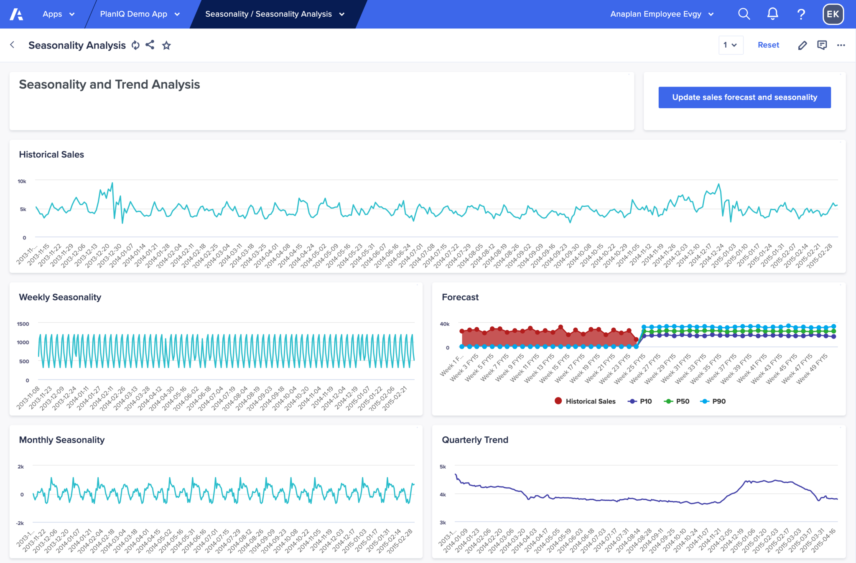Automatic trend analysis drives better business performance


Understanding hidden patterns in your historic data can help you plan better for the future. See how trend analysis can improve your planning and help you improve business performance in the future.
It’s no secret pinpointing emerging trends is key when it comes to making informed business decisions. Yet finding hidden trends in your data to help guide your next investment or product can often feel like a guessing game without the right tools. Making critical decisions without intelligent forecasting can impact profit and tarnish trust in the planning process.
For example, let’s look at the marketing department for a global games company. With a robust portfolio specializing in child development games, the team carefully optimized marketing spend across their selection to maximize revenue without over-saturating the market.
When tasked with introducing two new childhood development games to the market to help the company maintain its position as an innovator, the marketing team is faced with a difficult decision. How will they choose which games to continue to invest in and which to move marketing dollars from to pay for the launch and promotion of the new games?
A strategic approach requires them to understand which games are coming to the end of their product lifecycle and which are still on an upward trajectory. Using these insights, along with time series forecasting, it becomes easy to understand where demand will be for existing products. These insights will help drive an informed decision about which investments to focus on for future success.
Turn past data into future trends
Time series forecasting uses historical data coupled with related data and drivers to predict the future along a given time horizon. That’s a great place to start, but sometimes this only tells half the story.
Analyzing patterns in the underlying data reveals hidden trends, allowing you to better understand your data, and forecasts help you plan for the future.
Let’s go back to the game company. Using artificial intelligence, the marketing team can analyze historical data while considering the key buying seasons for children’s educational games. This analysis reveals one declining-stage game and five stable games. This is new information, because seasonality previously obscured consistent historical performance data.
Armed with this information, the team recommends moving 70% of the promotion budget from the decline-stage game and 20% from the five stable games to finance the two new game launches.
Doesn’t it feel good to make decisions based on data?
Types of trend analysis
Trend is only one type of pattern hiding in your data. Let’s look deeper at trend analysis and two other patterns helping you make better informed decisions:
-
- Trend: This shows the general upward or downward direction of your data and the inflection point when the trend started or changed. Although it sounds like this may be obvious, factors like seasonality or high variability can hide even a strong trend. Understanding whether your data, like customer demand, is heading up or down helps you make confident operational decisions.
- Seasonality: This is a repeating pattern over a specific interval of time with a fixed frequency: weekly, fortnightly, monthly, quarterly, or annually. As discussed earlier, knowing data seasonality can help you with things such as profit-maximizing investment decisions.
- Cyclical: This pattern shows fluctuations over time without a fixed frequency. You may notice over the course of a couple of years that you have peaks and troughs in your data. This may be tied to an event or macro-economic information. For example, during each summer Olympics, a cycling club may notice an increase in new members. This then tails off over the course of the following four years, then peaks again.
How does this impact my plans?
You may be thinking, “This is great information, but I have a great forecasting process so I don’t need to worry about understanding underlying patterns in my data.” Not so fast. Although forecasts can give you a more precise look at the day-to-day or week-to-week predictions, understanding the hidden patterns in your data allows you to make more general decisions and can impact how you plan on an ongoing basis.
Let’s look at some examples:
- Workforce planning and customer support team staffing: You work for a technology company supporting financial planning. Seasonality analysis showed you there’s an increase in support cases logged at the end of the month when more users are in the system. Managers can use this information to increase staffing levels for support analysts during that period relative to other times of the month, or they can move all non-case-related work earlier in the month to free analysts to focus on customer cases, increasing customer satisfaction.
- Supply chain and demand planning for a clothing retailer: You’re part of the demand management team at a global clothing retailer. You ran a trend analysis exercise and saw there’s a general upward trend for a racer-back tank tops for women and a downward trend for the women’s scoop-necked t-shirt. Knowing this, you can increase inventory for the racer-back shirt and decrease inventory for the scoop-neck shirt to increase revenues and reduce inventory carrying costs.
- Finance and operating expenses planning: You’re on the finance team for a large mining company. You need to understand costs and forecast what revenue needs to be earned to meet company goals. After running a trend analysis on your historical data, you noticed the cost of machinery maintenance increased during the past couple of years. Armed with this insight, you analyze mining operations and uncover efficiencies to improve the deployment of equipment and reduce wear and tear, lowering maintenance costs and saving the company hundreds of thousands of dollars each year.
- Reporting and getting future plan buy-in from executive leadership: You ran your forecasts and built an ambitious plan based on the results. Now you need executive buy-in for your plan. Thankfully, your forecasting tool provides a breakdown of the seasonality and trend patterns hidden in your data. You present this information with your plans to build trust in the forecasts and demonstrate that what initially seems like an extremely ambitious plan aligns with historic trends and demand patterns.

Although forecasts can never be 100% accurate, understanding the hidden patterns in your data can help planners make better decisions about the future. PlanIQ automatically breaks down historical data to show you seasonal and trend patterns hidden in your data. This data is added to the results export, making it easy to bring the results into Anaplan, allowing analysts and planners to work with the data easily and present it to executives to drive trust in plans.
